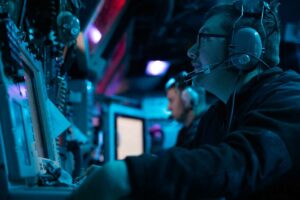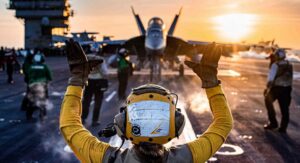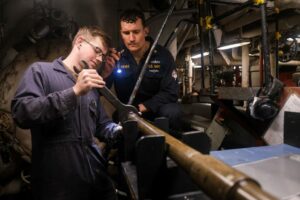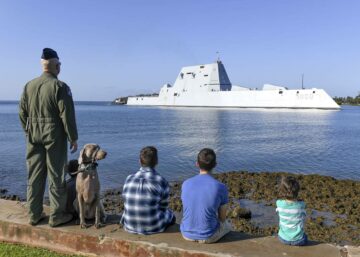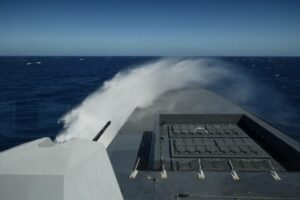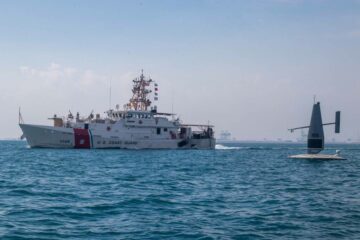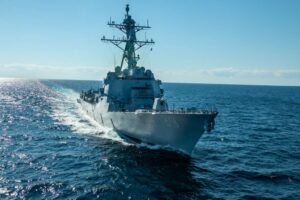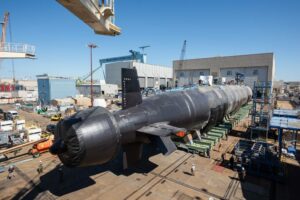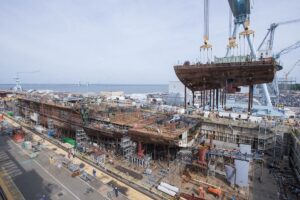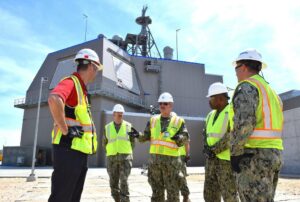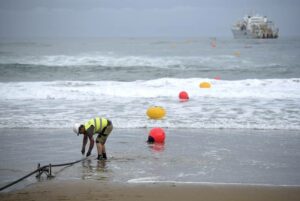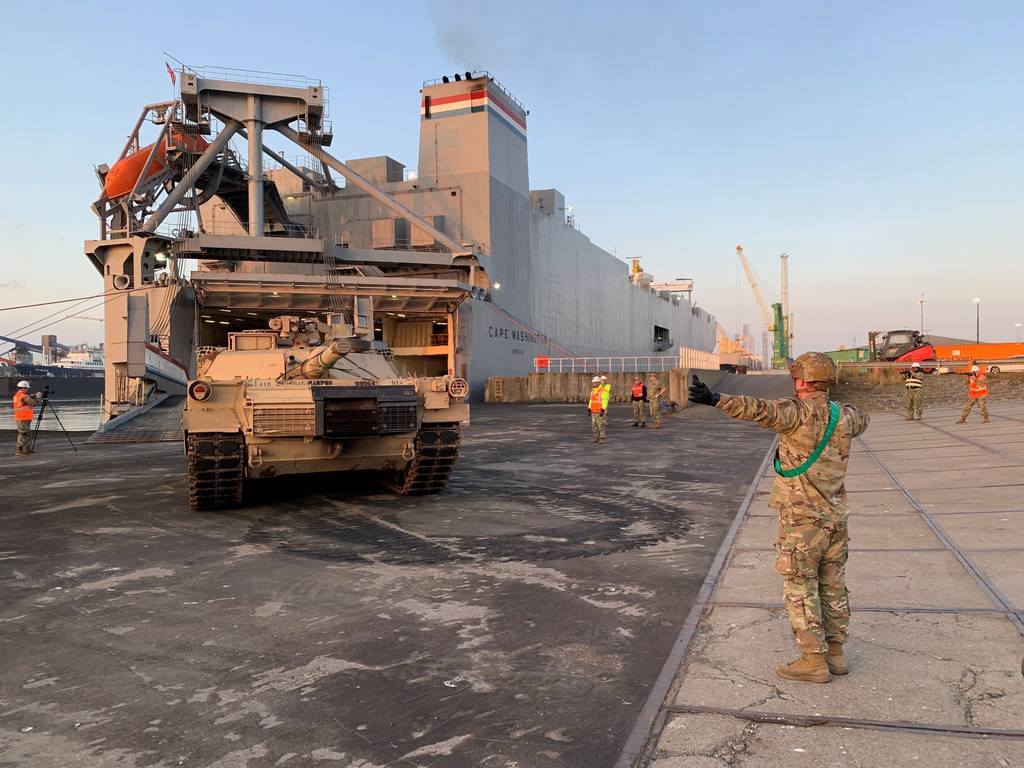
NATIONAL HARBOR, Md. — The U.S. Maritime Administration is pursuing a three-pronged approach to update and grow the nation’s surge sealift capacity, according to its leader Ann Phillips, but she can’t go after the third one until Congress funds it.
Following a 2018 requirements study by the Navy that, among other things, highlighted insufficient sealift, the Defense and Transportation departments developed a plan to recapitalize and extend the service life of some existing ships in the Maritime Administration’s sealift fleet. The plan also kicked off efforts to buy used sealift ships from the commercial market, which Congress authorized and for which the Navy budgeted at a rate of two per year. And finally, plans were made to design and build new ships.
That last one hit a snag last year when the House and Senate armed services committees authorized a new-construction sealift program, but the appropriations committees didn’t fund it.
“We’re moving forward … with all best speed to execute the Vessel Acquisition Management program, the buy-used [effort], with the assets that we have available,” Phillips said during a panel discussion at the Sea-Air-Space conference on April 3. “If an opportunity is presented to accelerate that, that is another way to move forward there.”
“With these three prongs, we’re focusing on the two that we have right now, the tools at our disposal: rehab-wise, and buy used. … As long as we are able to keep doing that, we begin to make headway” in making the sealift fleet larger and more capable, she added. “But we can’t afford a lapse, I’ll be honest there. Any hesitation, and we’re going to start to slip back.”
The Ready Reserve Fleet, which U.S. Transportation Command would call upon to move Army and Marine Corps gear into theater during conflict, and which is required to scramble into service on five days’ notice, is a subset of the Maritime Administration’s larger National Defense Reserve Fleet.
Today the Ready Reserve Fleet includes 45 ships with an average age of 45 years, Phillips said.
In congressional testimony to two House Armed Services Committee panels on March 28, Phillips said the Ready Reserve Fleet would soon grow to more than 50 vessels following both the transfer of a few Military Sealift Command vessels into her administration’s custody and the two-a-year procurement of used vessels from the commercial market.
But that’s still too small, warned military leaders, including Chief of Naval Operations Adm. Mike Gilday.
The Navy is conducting another study on its fleet size requirements based on the 2022 National Defense Strategy and evolving operating concepts like the Joint Warfighting Concept, he said at the Sea-Air-Space panel discussion.
“That applies to sealift as well. And so the sealift we needed, the current figures that we have, are grounded on analysis that was done decades ago. And so that’s an obvious question to ask: The Marines are operating differently. The Army’s operating a little differently. Exactly how much sealift do you need?”
Rep. Joe Courtney of Connecticut, the top Democrat on the House Seapower and Projection Forces Subcommittee, spoke forcefully at the March 28 hearing about the need to more rapidly grow the sealift fleet by building new ships in the United States. Today’s fleet faces an uphill battle to meet its mission due to its age, he said.
Philipps noted at the conference that some Ready Reserve Fleet vessels were activated to move weapons and supplies into Ukraine, but Courtney said in the hearing that mission was hampered due to ships breaking down.
‘Made in America’
Meanwhile, the Philly Shipyard is building a training ship — a National Security Multi-Mission Vessel — for the nation’s maritime academies. The business could continue building that same ship design to support the Ready Reserve Fleet, but only if appropriators earmark enough money for this last piece of the three-pronged approach.
Courtney called the training ship “one of the most promising ‘made in America’ programs.” These academy training ships already face the prospect of being scrambled into service in response to a military or first responder emergency, he added, but once the shipyard finishes building the five training ships, it could continue the production line and build more, albeit specifically devoted to sealift missions.
The shipyard “was almost down to 20 workers when this program started; it’s 2,000 today. And the fact is that they can take on more after they are done with this maritime training ship procurement, which is to basically have a ‘made in America’ sealift fleet. We do not need to be buying ships overseas on the used market. When will we learn the lesson of COVID, that international supply chains cannot be relied on in terms of price or accessibility, and we need to bring back the commercial and shipyard sector in this country? And we showed with this program that we can actually do it,” Courtney said in the hearing.
He later noted that the acquisition model used for this — the Maritime Administration hired a vessel construction manager to ensure the program stayed on track — has led the first ship, the Empire State, to remain on schedule and on budget. It will deliver to the Maritime Administration this summer.
In contrast to this predictability, he said he’s heard anecdotally that the pricing and availability of used ships isn’t steady right now, as demand for moving commercial goods globally remains high.
“I’m certainly ready to do everything I can to talk to appropriators about the fact that we really should not just put all our eggs in the commercial market” and should, instead, pay to build new ships.
The armed services committees last year wanted to build 10 new ships, and Courtney said he’d continue his push for funding to do so.
Megan Eckstein is the naval warfare reporter at Defense News. She has covered military news since 2009, with a focus on U.S. Navy and Marine Corps operations, acquisition programs and budgets. She has reported from four geographic fleets and is happiest when she’s filing stories from a ship. Megan is a University of Maryland alumna.
- SEO Powered Content & PR Distribution. Get Amplified Today.
- Platoblockchain. Web3 Metaverse Intelligence. Knowledge Amplified. Access Here.
- Source: https://www.defensenews.com/naval/2023/04/06/lack-of-funds-hampers-emergency-naval-fleet-from-growing-faster/
- :is
- 000
- 10
- 11
- 2018
- 2022
- 28
- 70
- a
- Able
- About
- Academy
- accelerate
- accessibility
- According
- acquisition
- actually
- added
- administration
- After
- All
- already
- among
- analysis
- and
- Another
- approach
- appropriations
- April
- ARE
- armed
- Army
- AS
- Assets
- Assistance
- At
- availability
- available
- average
- back
- based
- Basically
- Battle
- BE
- begin
- being
- BEST
- Breaking
- bring
- budget
- budgeted
- Budgets
- build
- Building
- business
- buy
- Buying
- by
- call
- called
- CAN
- cannot
- capable
- Capacity
- Cargo
- certainly
- chains
- chief
- commercial
- committee
- concept
- concepts
- Conference
- conflict
- Congress
- Congressional
- Connecticut
- construction
- Containers
- continue
- contrast
- could
- country
- covered
- Covid
- Current
- Custody
- decades
- Defense
- deliver
- Demand
- Democrat
- departments
- Design
- developed
- discussion
- doing
- DOT
- down
- during
- effort
- efforts
- Eggs
- emergency
- Empire
- enough
- enough money
- ensure
- everything
- evolving
- exactly
- execute
- existing
- extend
- Face
- faces
- faster
- few
- Figures
- Filing
- Finally
- First
- FLEET
- Focus
- focusing
- following
- For
- Forces
- Forward
- from
- fund
- funding
- funds
- Gear
- geographic
- Globally
- Go
- going
- goods
- Grow
- Growing
- Have
- heard
- hearing
- helicopter
- High
- Highlighted
- Hit
- House
- How
- HTTPS
- Humanitarian
- i
- I’LL
- images
- in
- includes
- Including
- instead
- International
- IT
- ITS
- joint
- jpg
- Keep
- Lack
- larger
- Last
- Last Year
- launching
- leader
- leaders
- LEARN
- Led
- lesson
- Life
- like
- Line
- little
- Long
- made
- make
- Making
- management
- manager
- March
- Marine
- Maritime
- Market
- Maryland
- Meet
- Megan
- Military
- Mission
- missions
- model
- money
- more
- most
- move
- move forward
- moving
- National
- national security
- Nations
- Need
- needed
- New
- news
- noted
- obvious
- of
- on
- ONE
- operating
- Operations
- Opportunity
- Other
- overseas
- pad
- panel
- panel discussion
- panels
- Pay
- piece
- plan
- plans
- plato
- Plato Data Intelligence
- PlatoData
- presented
- price
- pricing
- Production
- Program
- Programs
- Projection
- promising
- prospect
- Push
- put
- question
- rapidly
- Rate
- ready
- remain
- remains
- rendering
- Reported
- reporter
- required
- Requirements
- Reserve
- response
- s
- Said
- same
- schedule
- sector
- security
- Senate
- serve
- service
- Services
- ships
- should
- Shows
- since
- Size
- small
- So
- some
- Soon
- specifically
- speed
- start
- started
- State
- States
- stayed
- steady
- Still
- Stories
- Strategy
- Study
- subcommittee
- summer
- supply
- Supply chains
- support
- surge
- Take
- Talk
- terms
- testimony
- that
- The
- the joint
- Theater
- There.
- These
- things
- Third
- three
- to
- today
- today’s
- too
- tools
- top
- track
- Training
- transfer
- transport
- transportation
- u.s.
- U.S. Navy
- Ukraine
- United
- United States
- university
- University of Maryland
- Update
- Vehicles
- Vessel
- wanted
- Way..
- Weapons
- WELL
- which
- will
- with
- workers
- would
- year
- years
- zephyrnet

